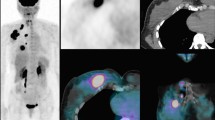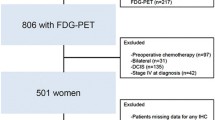Abstract
Purpose
The incidence of breast cancer has increased steadily. We performed a meta-analysis to assess the impact of 18F-fluorodeoxyglucose (FDG) positron emission tomography (PET) on the management of breast cancer with respect to the detection of recurrence/metastasis after curative surgery.
Methods
We performed systematic searches of the MEDLINE and EMBASE databases for English language publications. All published studies regarding the impact of PET on the management of patients with breast cancer with respect to the detection of recurrence/metastasis after curative surgery, such as mastectomy or lumpectomy, were searched. The proportion of management change (%), defined as the percentage of patients for whom management was changed after FDG PET among patients who underwent FDG PET, was calculated.
Results
Thirteen studies, which included 982 patients, were included in this study. The impact of PET was evaluated based on the proportion of management change, and a pooled effect of 44.4% was noted. In the subgroup analyses for (1) equivocal/suspicious recurrence/metastasis on conventional imaging, (2) abnormal symptoms or physical examination, and (3) elevated tumor markers (n = 834), the pooled rate of management change was 45.9%. In patients with elevated tumor markers (n = 350) and in those who underwent PET for routine surveillance, the pooled rates of management change were 52.3% and 12.4%, respectively.
Conclusions
18F-FDG PET has a major impact on the management of patients with breast cancer after curative surgery. These findings suggest that 18F-FDG PET should be performed in patients with breast cancer in cases involving equivocal or suspicious recurrence/metastasis on conventional imaging or in cases involving elevated tumor markers during follow-up. However, this study does not support the routine use of 18F-FDG PET for surveillance in breast cancer.




Similar content being viewed by others
Change history
10 May 2023
A Correction to this paper has been published: https://doi.org/10.1007/s40336-023-00564-6
References
Siegel RL, Miller KD, Jemal AJ (2020) Cancer statistics. CA Cancer J Clin 70:7–30
Kang SY, Kim YS, Kim Z, Kim HY, Kim HJ, Park S et al (2020) Breast Cancer Statistics in Korea in 2017: data from a Breast Cancer Registry. J Breast Cancer 23:115
Na KY, Kim KS, Lee JE, Kim HJ, Yang J-H, Ahn S-H et al (2011) The 70-gene prognostic signature for korean breast cancer patients. J Breast Cancer 14:33–38
Schmidt GP, Baur-Melnyk A, Haug A, Heinemann V, Bauerfeind I, Reiser MF et al (2008) Comprehensive imaging of tumor recurrence in breast cancer patients using whole-body MRI at 1.5 and 3 T compared to FDG–PET–CT. Eur J Radiol 65:47–58
Radan L, Ben-Haim S, Bar-Shalom R, Guralnik L, Israel OJ (2006) The role of FDG-PET/CT in suspected recurrence of breast cancer. Cancer 107:2545–2551
Ternier F, Houvenaeghel G, Lecrivain F, Le Brigand B, Margain D, Brunelle S et al (2006) Computed tomography in suspected local breast cancer recurrence. Breast Cancer Res Treat 100:247–254
Piva R, Ticconi F, Ceriani V, Scalorbi F, Fiz F, Capitanio S et al (2017) Comparative diagnostic accuracy of 18F-FDG PET/CT for breast cancer recurrence. Breast Cancer (Dove Med Press) 9:461–471. https://doi.org/10.2147/BCTT.S111098
Aukema TS, Rutgers EJ, Vogel WV, Teertstra HJ, Oldenburg HS, Vrancken Peeters MT et al (2010) The role of FDG PET/CT in patients with locoregional breast cancer recurrence: a comparison to conventional imaging techniques. Eur J Surg Oncol 36:387–392. https://doi.org/10.1016/j.ejso.2009.11.009
Isasi CR, Moadel RM, Blaufox MD (2005) A meta-analysis of FDG-PET for the evaluation of breast cancer recurrence and metastases. Breast Cancer Res Treat 90:105–112. https://doi.org/10.1007/s10549-004-3291-7
Lin CY, Lin CL, Kao CH (2018) Staging/restaging performance of F18-fluorodeoxyglucose positron emission tomography/magnetic resonance imaging in breast cancer: a review and meta-analysis. Eur J Radiol 107:158–165. https://doi.org/10.1016/j.ejrad.2018.09.003
Murray F, Freeman JWT (1950) Transformations related to the angular and the square root. Ann Math Stat 21:607–611
DerSimonian R, Laird N (1986) Meta-analysis in clinical trials. Control Clin Trials 7:177–188. https://doi.org/10.1016/0197-2456(86)90046-2
Higgins JP, Thompson SG, Deeks JJ, Altman DGJB (2003) Measuring inconsistency in meta-analyses. BMJ 327:557–560
Aukema TS, Rutgers ET, Vogel WV, Teertstra HJ, Oldenburg HS, Peeters MV et al (2010) The role of FDG PET/CT in patients with locoregional breast cancer recurrence: a comparison to conventional imaging techniques. Eur J Surg Oncol 36:387–392
Champion L, Brain E, Giraudet AL, Le Stanc E, Wartski M, Edeline V et al (2011) Breast cancer recurrence diagnosis suspected on tumor marker rising: value of whole-body 18FDG-PET/CT imaging and impact on patient management. Cancer 117:1621–1629
Chang H-T, Hu C, Chiu Y-L, Peng N-J, Liu R-SJ (2014) Role of 2-[18F] fluoro-2-deoxy-D-glucose-positron emission tomography/computed tomography in the post-therapy surveillance of breast cancer. PLoS ONE 2014:9
Cochet A, David S, Moodie K, Drummond E, Dutu G, MacManus M et al (2014) The utility of 18 F-FDG PET/CT for suspected recurrent breast cancer: impact and prognostic stratification. Cancer Imaging 14:13
Evangelista L, Panunzio A, Cervino AR, Vinante L, Al-Nahhas A, Rubello D et al (2012) Indeterminate pulmonary nodules on CT images in breast cancer patient: the additional value of 18F-FDG PET/CT. J Med Imaging Radiat Oncol 56:417–424
Filippi V, Malamitsi J, Vlachou F, Laspas F, Georgiou E, Prassopoulos V et al (2011) The impact of FDG-PET/CT on the management of breast cancer patients with elevated tumor markers and negative or equivocal conventional imaging modalities. Nucl Med Commun 32:85–90
Gallowitsch H-J, Kresnik E, Gasser J, Kumnig G, Igerc I, Mikosch P et al (2003) F-18 fluorodeoxyglucose positron-emission tomography in the diagnosis of tumor recurrence and metastases in the follow-up of patients with breast carcinoma: a comparison to conventional imaging. Invest Radiol 38:250–256
Grahek D, Montravers F, Kerrou K, Aide N, Lotz J-P, Talbot J-NJ et al (2004) [18 F] FDG in recurrent breast cancer: diagnostic performances, clinical impact and relevance of induced changes in management. Eur J Nucl Med Mol Imaging 31:179–188
Kim T-S, Moon WK, Lee D-S, Chung J-K, Lee MC, Youn Y-K et al (2001) Fluorodeoxyglucose positron emission tomography for detection of recurrent or metastatic breast cancer. World J Surg 25:829–834
Kubota K, Matsuno S, Morioka N, Adachi S, Koizumi M, Seto H et al (2015) Impact of FDG-PET findings on decisions regarding patient management strategies: a multicenter trial in patients with lung cancer and other types of cancer. Ann Nucl Med 29:431–441
Manohar K, Mittal BR, Senthil R, Kashyap R, Bhattacharya A, Singh GJ (2012) Clinical utility of F-18 FDG PET/CT in recurrent breast carcinoma. Nucl Med Commun 33:591–596
You J, Cline K, Gu C, Pritchard K, Dayes I, Gulenchyn K et al (2015) 18 F-fluorodeoxyglucose positron-emission tomography-computed tomography to diagnose recurrent cancer. Br J Cancer 112:1737–1743
Gradishar WJ, Anderson BO, Abraham J, Aft R, Agnese D, Allison KH, et al. Breast Cancer, Version 3.2020, NCCN Clinical Practice Guidelines in Oncology. Journal of the National Comprehensive Cancer Network. 2020;18:452–78.
Chang HT, Hu C, Chiu YL, Peng NJ, Liu RS (2014) Role of 2-[18F] fluoro-2-deoxy-D-glucose-positron emission tomography/computed tomography in the post-therapy surveillance of breast cancer. PLoS ONE 9:e115127. https://doi.org/10.1371/journal.pone.0115127
Evangelista L, Cervino AR, Ghiotto C, Al-Nahhas A, Rubello D, Muzzio PC (2012) Tumor marker-guided PET in breast cancer patients-a recipe for a perfect wedding: a systematic literature review and meta-analysis. Clin Nucl Med 37:467–474. https://doi.org/10.1097/RLU.0b013e31824850b0
Dalia DZ, Hasan MG, Tantawy MT (2013) Postoperative restaging: PET/CT impact on diagnosis and management. Egypt J Radiol Nucl Med 44:321–329
Funding
None.
Author information
Authors and Affiliations
Corresponding authors
Ethics declarations
Conflict of interest
No competing financial interests exist.
Ethical approval
This article does not contain any studies with human participants performed by any of the authors.
Additional information
Publisher's Note
Springer Nature remains neutral with regard to jurisdictional claims in published maps and institutional affiliations.
The original online version of this article was revised: In this article the affiliation details for Kyoungjune Pak were incorrectly given. It should have been ‘Department of Nuclear Medicine and Biomedical Research Institute, Pusan National University Hospital and School of Medicine, Pusan National University, Busan, Republic of Korea’.
Rights and permissions
Springer Nature or its licensor (e.g. a society or other partner) holds exclusive rights to this article under a publishing agreement with the author(s) or other rightsholder(s); author self-archiving of the accepted manuscript version of this article is solely governed by the terms of such publishing agreement and applicable law.
About this article
Cite this article
Pak, K., Yoon, HJ., Lim, W. et al. Impact of 18F-FDG PET on the management of recurrent breast cancer: a meta-analysis. Clin Transl Imaging 9, 255–263 (2021). https://doi.org/10.1007/s40336-021-00424-1
Received:
Accepted:
Published:
Issue Date:
DOI: https://doi.org/10.1007/s40336-021-00424-1




